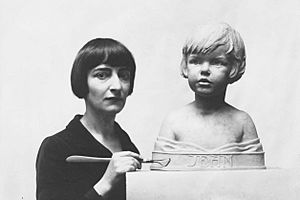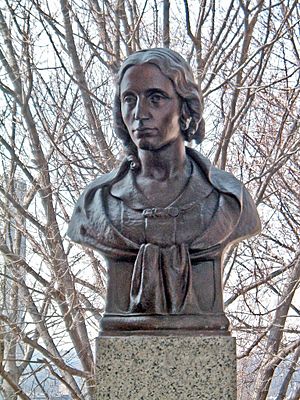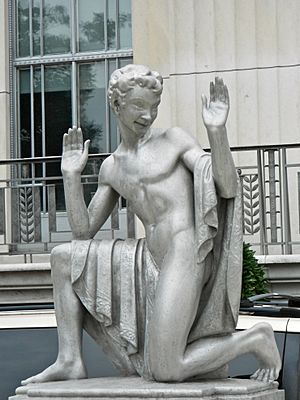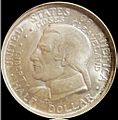Brenda Putnam facts for kids
Quick facts for kids
Brenda Putnam
|
|
|---|---|

Brenda Putnam with her Bust of Jean.
|
|
| Born | June 3, 1890 Minneapolis, Minnesota, U.S.
|
| Died | October 18, 1975 (aged 85) |
| Education | School of the Museum of Fine Arts Boston, Art Students League of New York Corcoran Museum Art School |
| Known for | Sculpture |
| Movement | Art Deco |
Brenda Putnam (born June 3, 1890 – died October 18, 1975) was an American artist. She was a talented sculptor, a dedicated teacher, and an author.
Contents
About Brenda Putnam
Brenda Putnam was born in Minneapolis, Minnesota. Her father, Herbert Putnam, was a very important librarian for the U.S. Congress. Her grandfather, George Palmer Putnam, was a famous publisher.
Brenda first learned to sculpt at the National Cathedral School in Washington, D.C. She was also a trained classical pianist. She even toured with a music group called the Edith Rubel Trio.
She studied art at several well-known schools. These included the School of the Museum of Fine Arts, Boston and the Art Students League of New York. She also studied at the Corcoran Museum Art School in Washington, D.C.
Her Early Artworks
When Brenda Putnam first started her career, she became known for her sculptures of children's faces, called busts. She also created beautiful figures for gardens and fountains.
She sculpted many famous musicians. These included opera conductor Artur Bodanzky and pianists Ossip Gabrilowitsch and Harold Bauer. She also sculpted harpsichordist Wanda Landowska.
One of her most famous early works was Sea Horse Sundial (1922). It shows a happy angel riding a seahorse like a toy horse. The shadow of the toy horse's stick tells the time on the sundial. This sculpture won many awards. She also created a large, detailed portrait of writer William Dean Howells in 1926.
Around 1920, Brenda shared a studio with another sculptor, Anna Hyatt Huntington. Anna later married a wealthy art supporter, Archer Milton Huntington. They became big fans of the arts. In 1931, they started Brookgreen Gardens. This is a huge garden in South Carolina filled with sculptures.
A New Style of Art
As time went on, Brenda Putnam wanted to try new things in her art. She felt that traditional sculpture was too old-fashioned. She wanted to create art with "a more modern aesthetic." To do this, she traveled to Italy in 1927 to study with artist Libero Andreotti. Later, she studied with Alexander Archipenko in New York City.
She worked with architect Paul Philippe Cret on the Puck Fountain (1930–1932). This fountain is at the Folger Shakespeare Library in Washington, D.C. Her sculpture of Puck sits on top of the fountain. Below it, you can read Puck's famous line from Shakespeare's play A Midsummer Night's Dream: "What fooles these mortals be." The original marble sculpture was moved inside the library to protect it. A new aluminum copy was placed on the fountain in 2002.
Brenda Putnam also showed three of her artworks at the 1932 Summer Olympics in Los Angeles. She also created large relief sculptures for two U.S. post offices. These projects were part of a government program called the Works Progress Administration.
During World War II, Brenda seriously hurt her arm in an accident. After that, she stopped making very large sculptures. She focused on smaller pieces and busts.
In 1945–46, she created a special medal for Admiral Ernest King. This medal was given to him for his great leadership of the U.S. Navy during World War II. She also created three portrait busts for the House of Representatives chamber in the United States Capitol. Her very last sculpture was a bust of Susan B. Anthony in 1952. This sculpture is in the Hall of Fame for Great Americans.
Brenda Putnam changed her style from traditional to Art Deco. However, she did not like the very modern art that became popular after World War II. She believed that museums should buy more realistic artworks.
Awards and Recognition
Brenda Putnam's art was shown in many important exhibitions. She exhibited her work at the National Academy of Design starting in 1911. Her Sea Horse Sundial won a prize there in 1922. She also showed her art at the Pennsylvania Academy of the Fine Arts for many years. Sea Horse Sundial also won a gold medal there in 1923.
She was elected as a member of the National Academy in 1934. She also became a member of the National Association of Women Painters and Sculptors. She even designed a special medal for them in 1941. She was also a member of the National Sculpture Society and served as its secretary.
Teacher and Author
Brenda Putnam was a teacher for 30 years. She taught at different schools and gave private lessons. She used her teaching experience to write a book called The Sculptor's Way: A Guide to Modeling and Sculpture. This book was first published in 1939. It is still considered a very important book for sculptors today. She also wrote another book called Animal X-Rays: A Skeleton Key to Comparative Anatomy.
Some of her students became famous artists themselves. These included Elfriede Abbe, Laura Gilpin, and Katharine Lane Weems.
Later Life and Legacy
Brenda Putnam never married. She had many long-lasting friendships with her students. She retired in the early 1950s and moved to Wilton, Connecticut. In 1971, she moved to Concord, New Hampshire, where she passed away in 1975.
Her sculptures are now in many famous museums. You can find her work at the Metropolitan Museum of Art, the National Gallery of Art, and the Smithsonian American Art Museum. Brookgreen Gardens also has several of her pieces.
Her personal papers are kept at Syracuse University. The Smithsonian American Art Museum also has a collection of photographs of her artworks.
Selected Artworks
Sculptures
- The Pigeon Girl (around 1919, bronze), at "Oldfields" in the Indianapolis Museum of Art, Indiana.
- Young Faun (1919, bronze), at the Dallas Arboretum and Botanical Garden, Texas. It shows a young faun stealing flowers.
- Sea Horse Sundial (1922, bronze), in Williamstown, Massachusetts.
- Elizabeth Sprague Coolidge Tablet (1925, marble), at the Library of Congress, Washington, D.C.
- Bas-relief Portrait of William Dean Howells (1926, bronze), at the American Academy of Arts and Sciences, Massachusetts.
- Harriet, Isabella and Katherine Beecher (1926, gold-painted bronze), at the Stowe-Day Foundation, Connecticut. This sculpture shows three sisters sitting on a park bench.
- Figure of Puck (1930–32, marble), at the Puck Fountain, Folger Shakespeare Library, Washington, D.C.
- Two Kids Sundial (1931, bronze), at Brookgreen Gardens, South Carolina. This sundial features a child and a young goat.
- Mid-Summer (1935, carved in marble 1946), at the Norton Museum of Art, Florida.
- Bas-relief lunette: Sorting the Mail (1936–37, plaster), for the Post Office in Caldwell, New Jersey.
- Bas-relief mural: Mississippi Divides the Southwest from the Northeast (1936–39, plaster), for the Post Office in St. Cloud, Minnesota.
- W. Albert Manda Memorial (1939), at Meadowland Park, South Orange, New Jersey.
- Communion (1939, bronze), at Brookgreen Gardens, South Carolina.
- Crest of the Wave (1939), shown at the 1939 New York World's Fair, New York City.
Cemetery Monuments
- Simon Memorial (1917, marble), at Rock Creek Cemetery, Washington D.C.
- Porter Monument (1931–32, bronze), at Allegheny Cemetery, Pittsburgh, Pennsylvania.
- Carefree Days (around 1932, bronze), Mead Monument, at Forest Lawn Cemetery, Glendale, California.
- Fortitude, Kindliness, Vision (1943, limestone), Morton Memorial, at Spring Hill Cemetery, Lynchburg, Virginia.
Busts and Statuettes

- Statuette of Sir Johnston Forbes-Robertson as Hamlet (1915, plaster; 1932, bronze), at the Folger Shakespeare Library, Washington, D.C.
- Bust of Herbert Putnam (1922), at the Library of Congress, Washington, D.C. This is a portrait of her father.
- Bust of Pablo Casals (1923, bronze), at the Hispanic Society of America, New York City.
- Bust of Harriet Beecher Stowe (1925, bronze), at the Hall of Fame for Great Americans, Bronx, New York.
- Bust of Wanda Landowska (1928).
- Bust of Amelia Earhart (1932, marble), at Syracuse University, New York.
- Bust of Ossip Gabrilowitsch (1933, marble), at the Detroit Institute of Arts, Michigan.
- Bust of John Mapother (1936, plaster), at the Speed Art Museum, Kentucky.
- Bust of Mary Baker Eddy (1937).
- Bust of Artur Bodanzky (by 1940), at the Hispanic Society of America, New York City.
- Bust of Harold Bauer (1949).
- Great Law-Givers: three relief portrait busts (1949–50, marble), in the U.S. House of Representatives Chamber, U.S. Capitol, Washington, D.C.
- Maimonides
- Solon
- Tribonian
- Bust of William Adams Delano (1950, bronze), at the National Academy of Design, New York.
- Bust of Susan B. Anthony (1952, bronze), at the Hall of Fame for Great Americans, Bronx, New York. This was Brenda Putnam's last completed sculpture.
Medals and Coins
- Charles P. Daly Medal (1924, bronze).
- Cleveland Centennial half dollar (1936, silver), minted 1936–1937.
- National Association of Women Artists Medal (1941, bronze).
- Amelia Earhart Medal (1941, bronze), at Princeton University Library, New Jersey.
- Flight Medal (1941–42, bronze), at the Snite Museum of Art, University of Notre Dame, Indiana.
- Admiral Ernest Joseph King Congressional Gold Medal (1945–46).
Images for kids





